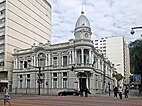Juiz de Fora | |
|---|---|
| Municipality of Juiz de Fora | |
| Nickname: JF | |
| Motto(s): Pro Patria et Urbe
"For the homeland and the city" | |
 | |
| Coordinates: 21°45′43″S 43°20′58″W / 21.76194°S 43.34944°W | |
| Country | |
| Region | Southeast |
| State | |
| Incorporated | 30 May 1850 |
| Government | |
| • Mayor | Margarida Salomão (PT) |
| Area | |
• Total | 1,436 km2 (554 sq mi) |
| Elevation | 678 m (2,224 ft) |
| Population (2022) | |
• Total | 540,756 |
| • Density | 376.64/km2 (975.5/sq mi) |
| [1] | |
| Time zone | UTC-3 (UTC-3) |
| • Summer (DST) | UTC-2 (UTC-2) |
| Postal Code | 36000-000 |
| Area code | +55 32 |
| HDI (2010) | 0.778 – high[2] |
| Website | www |
Juiz de Fora (Brazilian Portuguese pronunciation: [ˈʒwiz dʒi ˈfɔɾɐ]; lit. 'Outsider Judge'), also known as J.F., is a city in the southeastern Brazilian state of Minas Gerais, approximately 40 kilometres (25 mi) from the state border with Rio de Janeiro. According to the 2022 census the current population is 540,756 inhabitants. The geographical area of the municipality is 1,437 km2 (555 sq mi).
The city's location was a key factor in its economic and demographic development since it is situated between the three most important financial and economic metropolises of southeast Brazil (and also the three largest urban sprawls of the country): Rio de Janeiro (189 km (117 mi)), Belo Horizonte (260 km (160 mi)) and São Paulo (486 km (302 mi)). Major highways connect Juiz de Fora with these three metropolitan areas, the most important being the BR 040 which connects Brasília with Rio de Janeiro via Belo Horizonte. The city is built on the Paraibuna, a major tributary of the Paraíba do Sul river.
- ^ [1]
- ^ "Archived copy" (PDF). United Nations Development Programme (UNDP). Archived from the original (PDF) on 8 July 2014. Retrieved 1 August 2013.
{{cite web}}: CS1 maint: archived copy as title (link)









